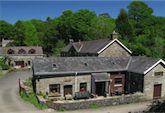Our self catering holiday cottages are situated on the edge of Fforest Fawr Geopark – one of the most exceptional geological sites in Europe.
Fforest Fawr (Great Forest) Geopark is set within the Brecon Beacons National Park and comprises the western half of the National Park, stretching from Llandovery in the north to the edge of Merthyr Tydfil in the south, from Llandeilo in the west to Brecon in the east.
In fact Fforest Fawr Geopark’s 300 square miles / 763 km2 include mountain and moorland, woods and meadows, towns and villages, lakes and rivers and a great deal more.
In medieval times, the word ‘forest’ meant a royal hunting ground. in places like Sherwood Forest and the New Forest they were full of trees and so the word has come to mean a wood, but the remains of the Great Forest have been tree-less for thousands of years.
There are 3 main types of rock in the Geopark – Old Red Sandstone, Limestone and Millstone Grit. They were formed at the bottom of rivers and seas, thousands of miles away and hundreds of millions of years ago. Earth movements have gradually carried them to their present location and forced them up to form mountains.
1. Old Red Sandstone
This reddish brown rock is made of mud and sand laid down in river beds and flood plains between 395 and 345 million years ago. Look closely and you will sometimes see sand ripples, like you find on a beach, fossilized into the rocks on some of our highest mountains. Many of the flat topped mountains with steep north-facing cliffs in the Brecon Beacons are made from this rock. The National Park is a short drive from our holiday cottages.
2. Limestone
Fossil seashells can sometimes be seen in this grey rock. They are the remains of coral and seashells deposited at the bottom of shallow seas between 359 and 328 million years ago. Limestone is full of fractures known as limestone pavements. It also dissolves in water, so rainwater and streams which trickle into the cracks have sloly created huge cave systems underground like Dan Yr Ogof caves – Britain’s Greatest Natural Wonder which is only a few miles from our self catering holiday cottages.
3. Millstone Grit
This rock is similar to limestone but contains rock and mineral bits instead of shells. It can range in colour from almost white to almost black. It is made from mud and sand that settled near the coastline and inthe sea 326 to 315 million years ago. The spectacular waterfalls around Ystradfellte and The Vale of Neath were formed where rivers drop off the edges of layers of Millstone Grit and have worn away a soft rocks underneath. Our self catering holiday cottages are conveniently situated for visiting “Waterfall Country”.
The Icing on the Geocake
The landscape was carved into the shape we see in South Wales today during the Ice Age, from 2 million to 12,000 years ago. Glaciers carved out the valleys of the Usk, Neath, Tawe and Cennen. Rocks which were gouged out by the glaciers were deposited along the sides and bottoms of valleys, or randomly scattered across the upland landscape. Our holiday cottages lie in the Tawe Valley.
280 – 500 million years ago
The rocks that make up the Geopark were formed in tropical seas, rivers and floodplains when Wales was situated closer to the equator.
2 million – 12,000 years ago
Huge glaciers carved the landscape into the shapes we see today, including the valley our cottages are situated in.
Around 5000 BC
Stone Age people began to settle in South Wales. They buried their dead in stone burial chambers. There are many sites to explore within easy reach of our holiday cottages, including many on the Gower Peninsula.
Around 2500 BC – 1500 BC
Bronze Age people erected standing stones and stone circles.
6th century BC – 1st century AD
Iron Age Celts built hillforts.
11th – 15th centuries
Stone castles were powerful strongholds for knights, princes and warlords. Our self catering cottages are convenient to many of Wales’s best castles including Carreg Cennen in the Brecon Beacons National Park.
18th – mid 20th centuries
Limestone quarries supplied materials for the ironworks of South Wales.
Today
The Geopark is a fantastic place to enjoy stunning landscapes and fascinating geology! Why not visit is as part of a cottage holiday in Wales?
For more information, see the official Geopark Website –
